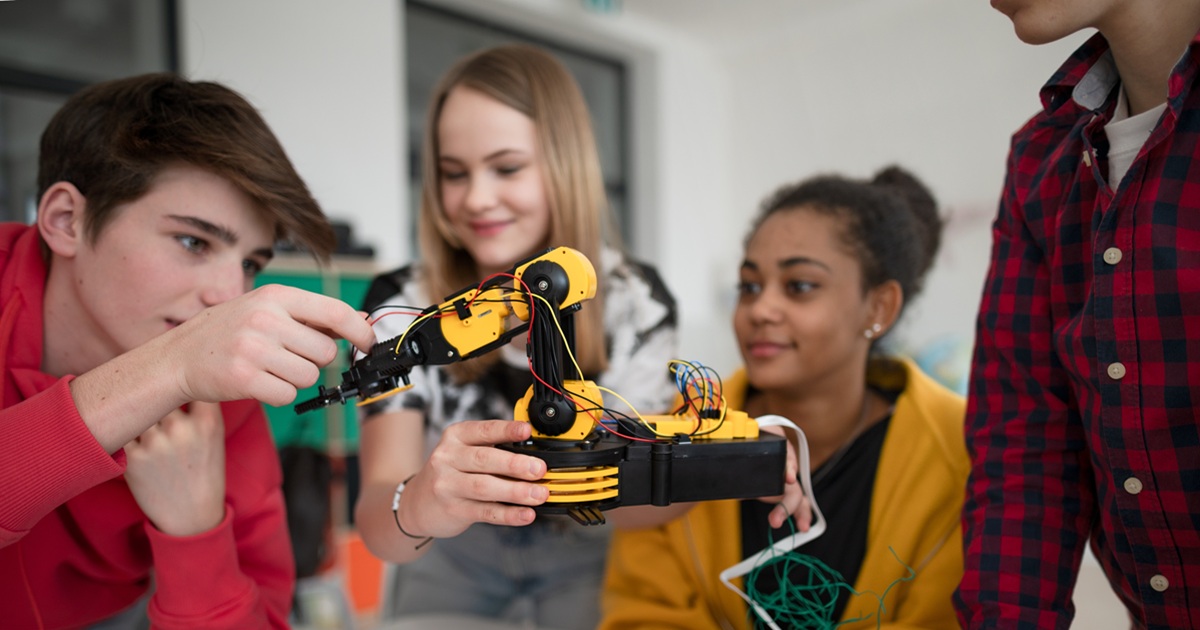
11+ Strong Class Projects for Middle School Engineering Classes
28
When science students combine their natural curiosity with engineering know-how, the sky’s the limit (literally, if you’re working on rockets)! With low-prep setup, challenging concepts, and the coolest finished projects ever, these class projects for middle school engineering classes are sure to inspire the next generation of future engineers in your class.
1. Make an indestructible cell phone case
Give the traditional egg drop challenge a 21st-century twist! Over the course of a week, groups of students design the most break-proof phone case they can with a variety of materials (including a calculator to use instead of a phone).
Perfect for an NGSS-aligned lesson on materials science or consumer engineering, this project can work for any number of fragile items inside an indestructible case, including a water balloon or delicate block creation.
2. Build the sturdiest bridge in class
One of the classic STEM activities for middle school, this team project uses elements of both mechanical and civil engineering, as well as teamwork. Provide students with basic building materials, such as popsicle sticks, straws, cardboard, and masking tape, and see who can create the strongest bridge that carries the most weight.
This project can take one to five class periods, depending on how detailed you want the bridges to be. For an ice breaker lesson in the first week of school, have the whole class work on one long bridge that stretches across the classroom!
3. Create race cars with everyday items
When it comes to engineering activities for middle school, nothing beats a race car — except another race car. Students work on cars that they’ll later pit against each other in the ultimate test of mechanical engineering, aerodynamics, and creativity.
Assign a specific type of race car construction project, such as rubber band cars, balloon cars, and bottle box cars, or allow students to use their own materials from home. Give teams or individuals one to three days to build their vehicles, make predictions on which cars would win in a head-to-head race, and get your engines started!
4. Engineer a hydraulic arm that really works
Let engineering lend you a hand, or even a whole arm. Students master the art of hydraulics and/or pneumatics with a creative project that brings multiple engineering types together. Without wiring, electronics, or robotic features, they can create an arm or claw that can really lift items up!
This easy engineering project for middle school may take a week or two of prerequisite lessons, planning, building, and demonstration. Consider having groups work together in a team-building exercise or letting individuals try their hand (get it?) at this project on their own.
5. Design an eco-friendly house for any climate
The next generation of engineers is going to need experience with environmental engineering and sustainable construction. Get them started early with an eco-friendly house planning project that involves architecture, energy-efficient design, and collaborative construction that might launch a few careers in green technology.
Use the eco-friendly engineering project in a unit on sustainable energy, after students have learned about solar panels, wind energy, and other ways to power a home. Have them finish their home within the week or stretch the project throughout the semester for students to tinker with their designs as they learn more about climate change.
6. Study cause and effect with a Rube Goldberg machine
When scientists think back on their favorite class projects for middle school engineering classes, they likely think about a Rube Goldberg machine. With just one movement, potential energy becomes kinetic energy, moving a marble through a series of mazes that lets students see cause and effect with their very own eyes.
A Rube Goldberg machine is a perfect way to start the school year in a middle school science or STEM class, as it lets students visualize the basics of engineering, physics, and construction. Or, the Rube Goldberg Institute for Innovation & Creativity hosts several contests throughout the year that your students could enter. Bring in cardboard and tape for students to use, and prepare to be amazed at what they come up with!
7. Work with chemical and electrical energy in a potato clock
How can a potato tell time? With its eyes! It’s not a great joke, but creating a potato clock is a great science experiment for middle school. Students see how chemical energy becomes electrical energy in an engineering and physics project that’s good enough to eat. (But don’t eat it.)
For a more illuminating take on the potato physics project, try making a potato battery and light bulb instead. This assignment can take students between one and three class periods to complete, depending on the sizes of the groups and their understanding of electrical engineering.
8. Make a solar oven that cooks
Watch a pizza box cook its own food with a solar oven project that demonstrates the transfer of energy. This thermal engineering project prompts students to use the materials at hand, including a box (pizza or otherwise), food to cook, and the sunshine on a bright, sunny day.
Plan on students taking around a week to finish their solar ovens, though block periods and extended building sessions may speed up the process. Provide marshmallows, chocolate, and graham crackers for groups to cook and enjoy s’mores in an especially delicious project test!
9. Let robots help with daily activities
What chores would you give a robot to complete? Middle schoolers put this question to the test when they use their knowledge of magnetism, robotics, and electrical engineering to create the most helpful robot possible. It can take a week or two for groups to finish their creations, unless you want to see what they can do in one class period!
Give students a scenario for their robots to complete, such as agricultural robots or bots that do household chores, or let them discover their own uses. Keep it simple with LEGO or other building materials, or make the project more advanced with coding and electric motors.
10. Use a spectroscope to see the world through new eyes
If you’ve always wanted to teach a light engineering lab but couldn’t afford a class set of spectroscopes, you’re in luck! Young engineers can get to work by building their own spectroscopes with common household materials, including empty paper towel rolls, blank CDs, and pieces of cardboard. They can also use PVC pipes and glue for a more advanced model.
Once they’ve finished their scopes, they can record their observations of the spectrum of light. Give students a day or two for building, then another few days for observing, recording, and presenting their findings.
11. Invent the world’s first hoverboard
Tomorrow’s toy is today’s engineering project! Using magnets or air pressure, students can experience the thrill of futuristic fun when they create hoverboards that really push off the ground.
While students may not be able to ride their hoverboards (unless your materials budget is really high!), they can test the durability of their projects with various weighted materials, such as small toys or paperclips. See which group can create a hoverboard that feels like it’s arrived from a time machine!
Easy One-Period Engineering Projects
Only have a day or two to finish a class engineering project? Use these easy STEM projects for kids that foster friendly competition and collaborative learning in a free class period or sub day.
- Paper Airplane Contest: Let students work in teams or as individuals to create the paper airplane that flies the farthest.
- Paper Boats: Whose paper boat can stay afloat the longest?
- Spinning Tops: Give students metal washers, toothpicks, clay, and string to build a top that keeps spinning.
- Lava Lamps: With just oil, water, food coloring, and fizzy tablets, students create lava lamps that feel like a blast from the past.
- Tallest Tower: Use toothpicks or pipe cleaners to build the tallest (and strongest) tower in class.
Engineer a class project they’ll never forget
Engineering is the process of solving problems with applied science. Whether they’re teaching students about mechanical engineering, electricity and power, or sustainable energy, these class projects for middle school engineering classes might flip the switch for tomorrow’s thought leaders and problem solvers.
Use additional middle school engineering resources to keep the learning going well after the projects are tested and graded. And when they’re ready, introduce class projects for high school engineering class to give middle schoolers a sneak peek into next year’s science assignments!
Source link



